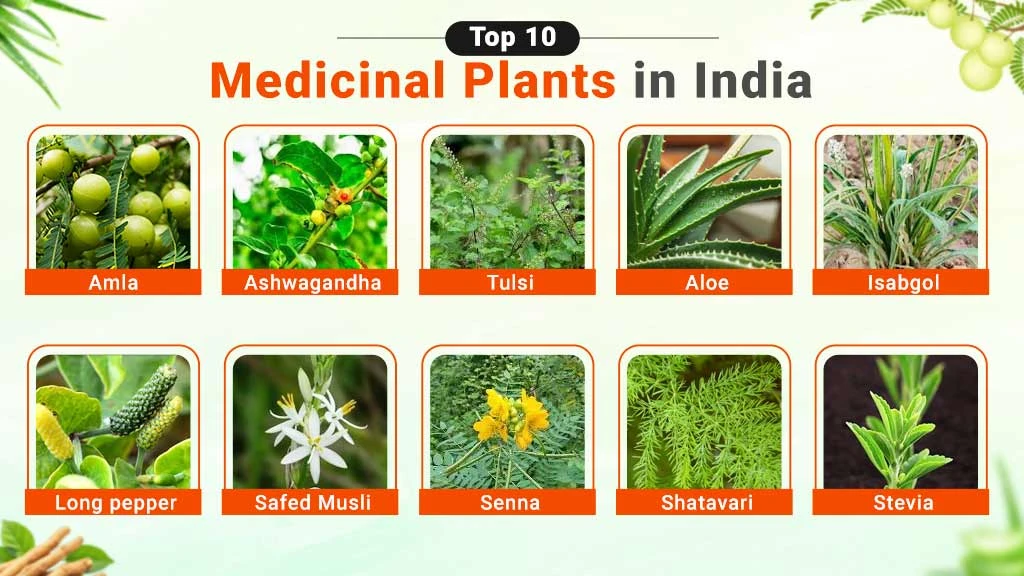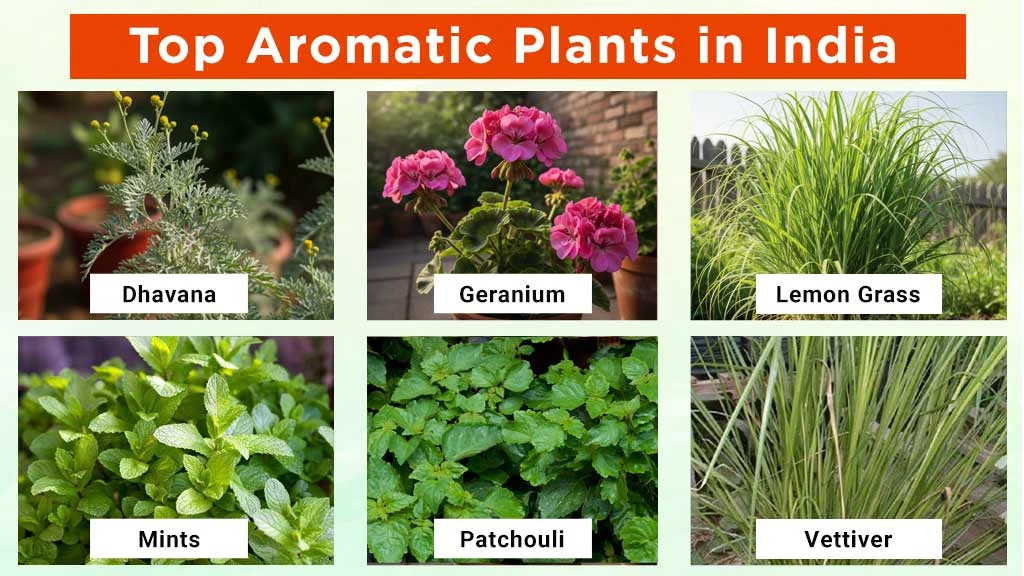Medicinal Crops Cultivation in India: Benefits, Types & Production

Medicinal plants are those that possess phytochemicals used for therapeutic purposes, to treat, cure, prevent diseases, and promote overall health. In this blog, we will learn about the medicinal and aromatic crops, benefits of medicinal crops, production, varieties, and government initiatives to promote their cultivation in India.
Table of Contents
- Overview of Medicinal Plants
- What are the Benefits of Medicinal Plants?
- Which are the Top 10 Medicinal Crops in India?
- Which are the Top Aromatic Plants in India?
- Which are the Top States Producing Medicinal Plants in India?
- What are the Government Initiatives to Promote Medicinal Crop Cultivation in India?
- Conclusion
Overview of Medicinal Plants
Medicinal plants, including herbs, shrubs, and trees, have been of great value in curing and preventing diseases for centuries. But the current allopathic drug system has put it in the background. However, in the current scenario, there is a worldwide awakening to return to traditional therapy. The most cost-effective way is to use medicinal plants to produce traditional medicine. For producing traditional medicines, a continuous supply of genuine raw materials is required, which is possible when medicinal plants are cultivated at a large scale.
The medicinal crop resource pool was abundant in the forest, but it has been decreasing drastically due to the rapid decline of forest areas resulting from anthropogenic pressure. Thus, the only way to obtain more raw materials is through the cultivation of medicinal crops in agricultural lands. Cultivating medicinal crops commercially is one of the most profitable agribusinesses for farmers in India.
What are the Benefits of Medicinal Plants?
Medicinal crops offer different health benefits, such as:
- Many herbs, such as black pepper, myrrh, sandalwood, cinnamon, aloe vera, bayberry, burdock, red clover, ginseng, and safflower, are used for the treatment of sores, wounds, and boils.
- Some herbs, popularly known as blood cleaners, are used as blood purifiers to transform or improve a long-term state by eliminating metabolic toxins. Herbs can also boost the immune system of a person, reducing the risk of illnesses, such as fever.
- Some medicinal plants possess antibiotic properties. For example, turmeric can inhibit the growth of bacteria, germs, and other harmful organisms. It is also a popular home treatment for cuts and wounds.
- Sandalwood and Cinnamon are considered good astringents. Sandalwood is used to stop blood flow, mucus, and other bodily fluids.
- Several medicinal plants are recommended to neutralize the stomach’s acid. For example, marshmallow roots and leaves are used in cooking. They help to keep the necessary stomach acids for effective digestion.
- Cough syrups made from ginger and cloves are quite famous, known for their expectorant properties, helping mucus to thin and eject from the trachea, lungs, and bronchi. Expectorants include things such as cardamom, eucalyptus, cloves, and wild cherries.
- Few herbs, such as barberry, aloe, seal, golden seal, and giloe, are used as tonics. They can also act as nourishing and rejuvenating for both sick and healthy people.
- Honey, marshmallow, turmeric, and liquorice are known as vulnerary herbs, used to treat fresh cuts and wounds.
Which are the Top 10 Medicinal Crops in India?

The top medicinal plants list in India includes amla, ashwagandha, tulsi, aloe, isabgol, long pepper, safed musli, senna, shatavari, and stevia. Let’s discuss each of them in brief:
- Amla: Amla is considered a good liver tonic. It has many medicinal properties, such as anti-scorbutic, laxative, diuretic, antibiotic and anti-dysenteric. Its fruits are a rich source of Vitamin-C (700 mg per 100 grams of fruit).
- Ashwagandha: Ashwagandha is rich in different types of alkaloids, in which Withanine and Somniferine are popular. Its leaves consist of five unidentified alkaloids (0.09%), glycosides, withanolides, glucose, and many free amino acids.
- Tulsi: The Tulsi plant enjoys religious attachment and is often grown in shrines and homes as an aromatic perennial shrub. It has antimicrobial and antiviral properties and purifies the air. Its leaves contain bright yellow volatile oil, which is quite useful against bacteria and insects.
- Aloe: Aloe comes in various varieties, including Aloe vera, Aloe ferox, Aloe perryi, and many others. They are widely grown for aloe gel, which has many medicinal uses.
- Isabgol: The seed husk of isabgol is used to cure inflammation of the mucus membrane of gastrointestinal and genito-urinary tracts, dysentery, chronic constipation, gonorrhea, duodenalulcers, and piles. It is widely used in setting lotions, calico printing, and the food industry.
- Long pepper: The spikes of long pepper contain piplartine and piperine alkaloids. Its roots and fruits possess a bitter and hot, sharp taste, widely used in gout, palsy and lumbago.
- Safed Musli: Safed Musli is rich in carbohydrates (41%), protein (8-9%), saponins (2-17%), and root fibres (4%). The chief medicinal compound present in its roots is known as Saponin. Its roots have a well-known tonic, used in the care of general debility by acting as an aphrodisiac.
- Senna: Senna is an important source of organic laxatives. Its leaves and young pods consist of sennosides, which are considered laxative principles. It is an effective drug for habitual constipation and has a worldwide demand for use in pharmaceutical industries or as a household drug.
- Shatavari: It is an indigenous medicinal plant widely used in Siddha and homoeopathy medicines. Its roots are mainly used as galactagogue, which stimulates the secretion of breast milk.
- Stevia: Stevia consists of stevioside (3-10%), rebaudiside-A (13%), rebaudiside-B and C. It is widely used as a calorie-free sweetener and a sugar substitute for diabetic patients.
Which are the Top Aromatic Plants in India?

The popular aromatic plants examples in India are:
Which are the Top States Producing Medicinal Plants in India?
India is a major producer of medicinal crops worldwide, with Rajasthan accounting for 56% of the country’s total area under medicinal crop cultivation. It is followed by Uttar Pradesh (25%), Madhya Pradesh (11%), Tamil Nadu (2%), Punjab (2%), Chhattisgarh (2%), Andhra Pradesh (1%), and Bihar (1%).
The top 5 states producing medicinal plants in India are:
|
State Name |
Percentage of Production |
|
Madhya Pradesh |
44% |
|
Rajasthan |
19% |
|
Tamil Nadu |
16% |
|
Chhattisgarh |
8% |
|
Arunachal Pradesh |
7% |
What are the Government Initiatives to Promote Medicinal Crop Cultivation in India?
The Quality Council of India (QCI) and the National Medicinal Plants Board (NMPB) jointly launched the voluntary certification scheme for medicinal plants. This scheme benefits medicinal plant producers, groups of producers, collectors, dealers, herbal medicine manufacturers, societies, the AYUSH sector and the AYUSH customers because of the guaranteed quality of medicinal plants and herbs.
The various components of National Ayush Mission include conservation, research & development, IEC & Training, Herbal Garden, Marketing & Trade, and International Cooperation.
Conclusion
Medicinal herbs farming offers numerous potential in India, and several factors, including land prices, transportation costs, labor costs, and many others, determine its profitability. The Indian government has also expressed interest in expanding medicinal plant cultivation, which is why several schemes have been launched. For more details on these schemes, explore Tractorkarvan at your convenience.
Frequently Asked Questions On Medicinal Plants Farming in India
1. Which is the best medicinal plant in India?
Tulsi is the best medicinal plant in India.
2. How many medicinal plants are there in India?
More than 8000 species of medicinal and aromatic plants are found in India.
3. Which is the oldest medicinal plant?
Ephedra is often cited as one of the oldest medicinal plants because of its uninterrupted use in traditional medicine.
4. What are traditional medicinal plants?
Traditional medicinal plants are diverse plants, herbs, and their compounds used for healing across various cultures and eras.


Related Blogs












